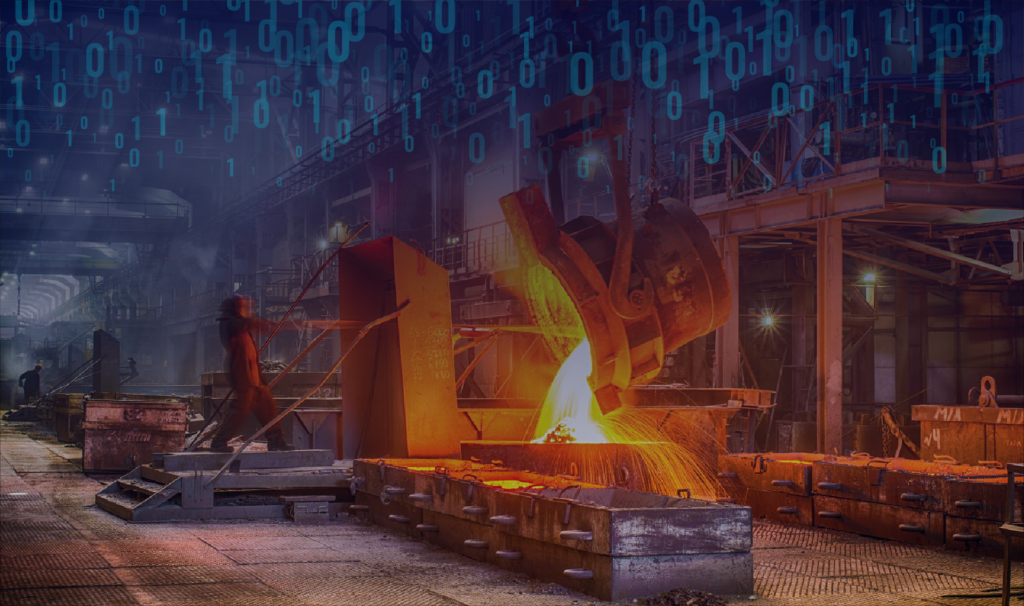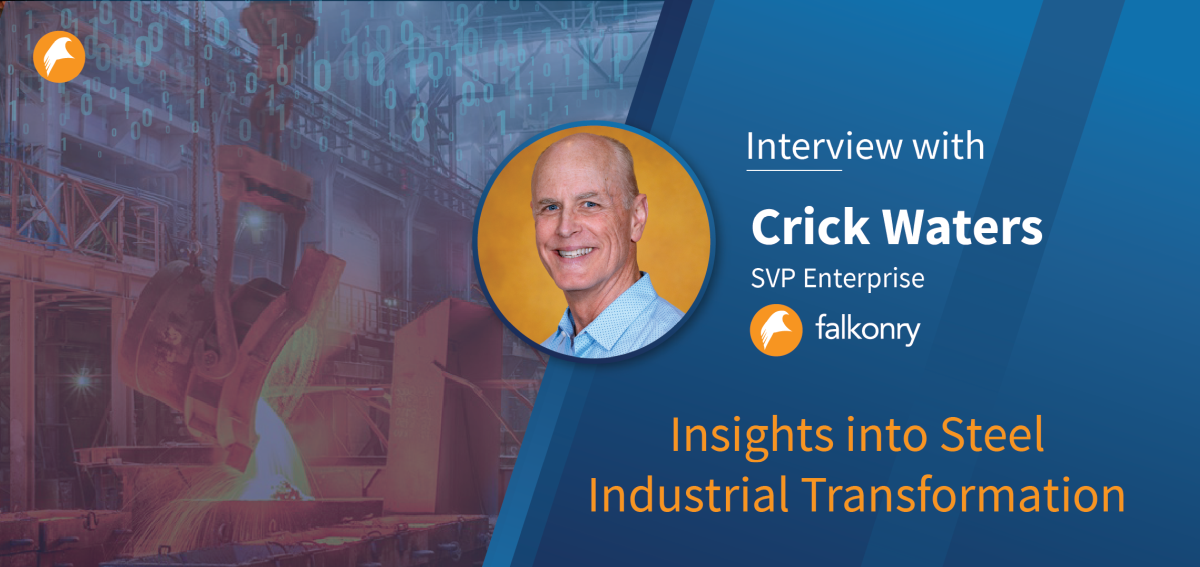AI implementation challenges in steel manufacturing
Key takeaways:
- The complexity and scale of steel plants mean that human teams are always chasing after-the-fact explanations.
- Productized time series AI is leading to a recognition that insight into continuous real-time manufacturing operations can be automated and automated at scale.
- Successful transition from POC to operational adoption requires automated AI and creating an organizational structure and information flow that facilitates action.
Time and again reports such as McKinsey’s State of AI survey reveal that while adoption of AI continues to rise, getting significant value remains a challenge across industries. For AI implementation to be successful, the right approach and technology need to be deployed while mitigating intervening risk factors. In this blog post we discuss some common AI implementation challenges and how steel manufacturers might be able to overcome them.
Forensic methods cannot be scaled
Historically, steel manufacturers have been very adept at using forensic analytics tools to understand events post-mortem. However, the cost of scaling the humans to use those methods across all of their assets is prohibitive since the time that it takes to do any individual forensic analysis is long. Furthermore, the value of real-time inference from operating conditions is significantly greater than that of human forensic analysis performed after an event of interest has already occurred. The emergence of AI and, more importantly, productized time series AI is leading to a recognition that insight into continuous real-time manufacturing operations can be automated and automated at scale.
Lack of real-time operational insights
A steel plant is a complex and dynamic environment comprising thousands of assets that are continuously wearing, changing, and failing. A typical integrated steel manufacturer might have 36,000 assets critical to operations and another 100,000 non-critical assets. Currently, operations teams can only react to operational upsets after they occur and, at best, react to only those related to a handful of assets. The complexity and scale of steel plants mean that human teams are always chasing after-the-fact explanations – they simply cannot watch all assets all the time or diagnose asset behaviors while they are in use.
This is where AI comes in. Time series AI can be the “eyes and ears” for human operations teams. Steel plants need a system that can continuously observe all the operating parameters from assets at the line and plant level. Such a system can “watch” in real-time, immediately providing insights into what systems or assets need attention as behaviors that need attention emerge. The leaders in this space who are experiencing success with their digital transformation efforts have realized that getting real-time insights at scale and making them accessible to end-users is of utmost importance. AI makes it possible for operations teams to keep an eye on the whole plant as it operates and respond to events of interest at the earliest, leading to timely and informed interventions.
Data Integrity
Another problem that steel manufacturers face as they adopt AI at scale is data integrity. Many metals manufacturers have indeed been collecting data for years. Systems like those from iba can collect data at sub-millisecond rates, so companies often have vast quantities of data being generated and stored. A few production lines can generate over a terabyte of data every month.

A surprising example of a data integrity challenge is tag names. It isn’t uncommon for plants to change tag names over time. One production line might experience 3.5% tag name changes over a five-year period (280 tag name changes every year for one line). While name changes pose no real problem for post-event forensics, they’ll stop a real-time AI dead in its tracks. Similarly, a sensor going offline may not affect a process control loop, but an AI that depends on the sensor values for continuous analysis will grind to a halt without all of its expected inputs. Other data wrangling activities like column and row rationalization are not significant challenges for desktop analytics but require clever signal processing for real-time AI.
These types of data integrity issues can be handled by sophisticated time series AI platforms like Falkonry’s. Failing sensors become reportable occurrences. The platform can identify a failing sensor and provide an auto-generated report to the operations team that includes signal traces, sensor ID, and location, as well as what real-time AI models will be incapacitated until the sensor integrity is restored. Similarly, it can alert operational technology teams of unexpected tags or tag name changes automatically, while being capable of ingesting 10s of 1,000’s of parameters at millisecond sampling rates in real-time.
POC Purgatory
When one considers the adoption of AI in steel or metals production, one has to consider the much-talked-about POC purgatory problem. We’ve observed manufacturers routinely struggling with scaling analytics beyond POCs. There are two reasons attributable to AI scaling challenges: method and people and people-led processes.
The first challenge to scaling AI is the “method.” It’s impossible to consider AI without “data science” coming to mind, and therefore it is natural that the method of developing and delivering AI-based solutions has been historically through the lens of data scientists. The data science method, if you will, starts with a point problem and proceeds with data collection and model development using “supervised learning” techniques. When time and resources are such that precise data and fact collection can be achieved, this method can yield high precision custom-crafted AI models. But this tendency to use historical data to build custom-crafted future-facing models has limitations.
The most notable limitation of this data science method is that real production environments are dynamic. Minute-by-minute the data and facts that were used in the past become less and less relevant. Business pressures compel operational states to change rapidly. Equipment and processes evolve such that old models don’t detect new failures, or see new normals as false positives. Furthermore, real-world failures are not precisely repeatable. These production and failure mode uncertainties lead to “model-churn” – a phenomenon wherein the time-taking trained and validated model can already be obsolete as it nears deployment.
An automated AI that requires no manual training is needed to use AI at scale in metals manufacturing. Consider that a global steel manufacturer with 15 production lines might use 350,000 parameters to monitor 130,000 assets across all aspects of production. Using custom-crafted data science point solutions at this scale is untenable. However, unsupervised univariate auto-anomaly detection in signal and asset hierarchies in a time series AI platform can be applied at scale. An application suite built on such a time series AI platform applied to aggregated signals by asset classes monitored with unsupervised AI provides tiered intelligent decision support for operations and maintenance teams at plant scale.
The second challenge lending to POC purgatory is people and people-led processes. The people component combines adoption, organizational design, and process. The outputs of an AI system are new pieces of information that plants don’t have today. With new information, new questions arise, such as, “Who should receive the notifications or reports from a time series AI platform?” “What are the responsibilities of those persons and to whom are they responsible?” “How is the information that comes from the AI platform converted into actions?” This last question is the crux of the challenge: Information can only inform actions; it’s the actions that change outcomes.
Successful transition from POC to operational adoption involves creating an organizational structure and information flow across that structure from AI insight through the decision to action. Most operational impacts come from maintenance actions. The decisions to schedule and effect maintenance can be supported by AI insights but it takes people to interpret, accept, and convert the insights into actions.
Adding to the challenge of organizational design and information process flow from insight to decision, is the fact that adverse production-impacting events are rare, and what an AI might see in data may not be visible to human operators. Trust in AI insights requires explainable AI – something that Falkonry’s time series AI focuses on. The need for a robust human link in the chain between data and decision cannot be overemphasized.
Limited buy-in from the operations team
The “human” component of a production system must also be accounted for. Change is difficult for most individuals, and even more difficult for people that have to effect organizational change together. The natural difficulty we all face in changing behavior is the source of one of the most important challenges – that of limited buy-in from the operations team. The challenges of generating and maintaining buy-in from the operations personnel in support of AI-driven operational processes is topic all to itself. But generally what we have noticed working with our customers is that if a system is easy-to-use and it helps the end-users (i.e. the ops personnel) with their day-to-day work, its usefulness becomes self-evident. Eventually, users start seeing value in the AI-assisted decision-making approach and the trust in the system builds further, thereby proliferating buy-in.
In conclusion…
Organizations seeing the highest returns from AI are the ones that are addressing these challenges successfully. Often that recipe for success involves a rethinking of deployment strategy and adoption of an automated AI platform adept at both unsupervised and semi-supervised learning. If you’d like to discuss how Falkonry can help overcome some of these barriers, reach out to us for a briefing and demo.





